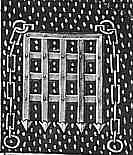|
This
document has a number of decorative elements, but all of them have a particular
significance. |
 |
The
historiated initial
T depicts the ceremonial ratification of the
agreement. The chancellor with his minions sits on the left while the
abbot, complete with mitre, sits with his tonsured monks on the right.
In the centre stands a book on a lectern, presumably representing the
agreements themselves. The way it is depicted, with the priest standing
in front of it, is reminiscent of images of priests reading or chanting
the liturgy
in church, with a large and weighty Bible
or missal in
front of them. |
| The
whole composition is one of those "life imitates art imitates life" type of reflexive images so intriguingly found in medieval art. The association
of the act of finalising the agreement with an image itself associated with
solemn sacred ritual imbues the whole legal process with the significance
of liturgical acts. In other words, if the king has any ideas about not honouring
his agreements, he is being reminded of what he is dealing with! |
 |
The
royal arms adorns the head of the page. The king had his own symbolism for
displaying his temporal significance. The arms of England and France are present. |
 |
There
are several representations of a portcullis, which was a personal badge
of Henry VII. It is found on collars on funerary sculptures of his knightly
followers, and is festooned all over Kings College Chapel, Cambridge.
It is said to represent the freeing of England from its incarceration
by the evil Richard III, but that might be just one of those stories. |
 |
During
the long period of civil violence known as the Wars of the Roses, the Yorkists
took the emblem of the white rose and the Lancastrians the red rose. Every
school kid knew that once. Henry Tudor, on becoming king of England, used
a red and white rose as the symbol of the Tudor dynasty and the reuniting
of Britain. Then he got the idea that he was King Arthur and things got all
very symbolically confused, not to mention historically garbled. Pity we can't
actually see what colour these roses are. |
|
Abstract
of Agreement, 1500, British Library, Harley 1498, f.76. All
images by permission of the British Library. |
|
|
overview | decoration | text
| alphabet | abbreviations
| exercises | transcript
| |
|
Click
on each of the above to walk your way through the text. The transcript
will appear in a separate window so that you can use it for reference
at any time. These exercises are designed to guide you through the text,
not test you, so you can cheat as much as you like. |
|
 Script sample for this example Script sample for this example |
 Index
of Exercises Index
of Exercises |
 Index
of Scripts Index
of Scripts |
|
 |
 |
 |
 |



